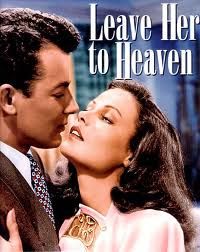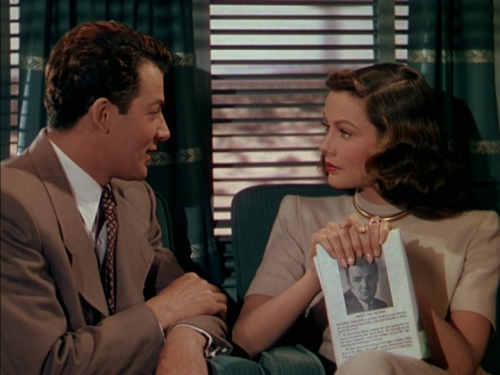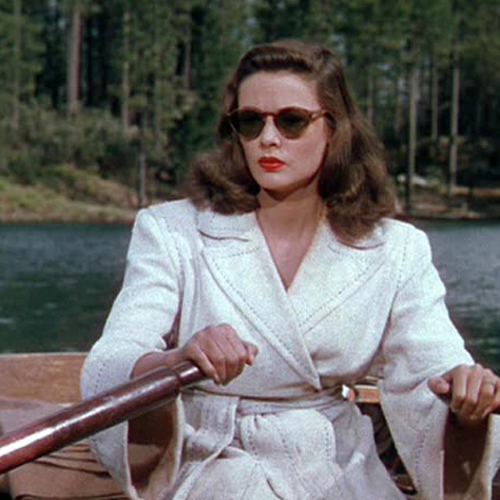 Leave Her to Heaven/1945/ Twentieth Century Fox/110 min.
Leave Her to Heaven/1945/ Twentieth Century Fox/110 min.
“Leave Her to Heaven” shows a glossy new strand of film noir: a domestic-based story shot in color. Of course, there were mixed-up families all along and melodrama was nothing new – Joan Crawford won the Best Actress Oscar for “Mildred Pierce,” also from 1945. But here we are immersed in the inner-workings of an upper- middle-class, superficially happy clan and witness the deadly consequences of Daddy complexes. (Yes, there is a family-size helping of obvious Freudian psychology.)
Gene Tierney tackles the role of Ellen Berent – ravishingly beautiful, rich as a princess, and smart as a tack. (Rita Hayworth reportedly turned the part down.) Shortly after the death of her father, she meets a handsome novelist named Richard Harland (Cornel Wilde) who looks and acts like Dad. Ellen’s quickly heads over heels and in short order she dumps her fiancé, aspiring politician Russell Quinton (Vincent Price), and marries Richard.
Breaking the noir convention that a femme fatale typically has a tough childhood and few remaining family ties, Ellen comes from a wealthy and well respected East Coast family. Ellen’s mom (Mary Philips) says: “There’s nothing wrong with Ellen. It’s just that she loves too much. She loved her fahhhther too much.”
We also learn that Richard has a younger brother Danny (Darryl Hickman) who’s an invalid and, in Ellen’s view, really a bit of a third wheel. For you see, the lovely Ellen is turning out to be a green-eyed monster fond of sticking to her husband like glue.
To top it off, Richard has the irritating notion that he’s The Writer of the House and needs some time to himself To Write. Seriously, Richard?
As Ellen’s paranoia and possessiveness grow, her cousin Ruth (Jeanne Crain) appears strikingly sane by contrast and hence more competition for Richard’s attention. Ellen may be clinical, but she’s not stupid, so once she decides that Richard no longer wants her, she sets an If-I-can’t-have-him … trap. She also commits one of the most cold-blooded killings in the film-noir canon.
A big-budget production with a strong cast, “Leave Her to Heaven” is immensely entertaining. (Price and Tierney had worked together in 1944’s “Laura” as well.) For one thing, it’s drop-dead gorgeous. Shot in luscious Technicolor by cinematographer Leon Shamroy (he won an Oscar for this film) with frothy art direction by Maurice Ransford and Lyle Wheeler, “Leave Her to Heaven” is a feast for the eyes.
Another highlight: John M. Stahl’s elegant direction. Known for women’s films such as “Back Street (1932), “Imitation of Life” (1934) and “Magnificent Obsession” (1935) as well as the MGM flop “Parnell” (1937), Stahl could make a stylish soap opera like nobody’s business. The executive producer was Darryl F. Zanuck (uncredited).
(Following in Stahl’s soap-opera tradition was the great Douglas Sirk, known for his lavish productions underpinned with stinging social criticism. He remade “Magnificent Obsession” in 1954 with Rock Hudson and “Imitation of Life” in 1959 with Lana Turner.)
The source for “Leave Her to Heaven” was Ben Ames Williams’ novel “Leave Her to Heaven” (a line from “Hamlet”). The book was a best seller that prompted a bidding war among studios wanting to make the movie. Jo Swerling wrote the screenplay.
In the DVD version, actor Hickman and film critic Richard Schickel provide commentary. Hickman tells us that Tierney didn’t give him the time of day and he couldn’t seem to please Stahl, then picks on Tierney’s acting. But then he did apparently get pneumonia from shooting the famous lake scene so that might sour one just a tad.
Schickel’s comments are far more interesting, especially his insightful observation about fashion. Despite her issues, Ellen is dressed to a T in every scene, looking icy cool, highly polished and timeless. And when you come down it, what’s more important than that? Neurotic, schmurotic.












From FNB readers